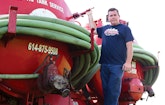
Interested in Business?
Get Business articles, news and videos right in your inbox! Sign up now.
Business + Get AlertsIn Chuck Lang Jr.’s area of central Ohio, competition has become fierce for septic tank pumping over the past 10 years. Yet his company — Chuck’s Septic Tank, Sewer & Drain Cleaning in Grove City — has roughly tripled in size since 2014.
While that may sound counterintuitive, the name of the company explains how it happened. The business — established by Lang’s father, Chuck Lang Sr., in 1970 as Chuck’s Septic Tank — does more than just pump septic tanks. It also pumps grease traps, recycles oil and grease, inspects pipelines and cleans sewers and drainlines throughout Ohio.
“It was hard for us to branch out (into more septic tank pumping),” says Lang, 48. “It’s certainly not the easy choice to enter new markets because it comes with expenses. You take a gamble that a machine — like a $40,000 or $50,000 trailer jetter — will pay for itself.
“My dad took that chance when he bought a truck jetter in 1979,” he continues. “He saw a market niche in drain cleaning. We couldn’t get some lines open, and that was making us look bad. He hated not being be able to complete a job. He’d then have to give the business to one of our competitors, and once that happens, you never get it back. So he figured he had to do something.”
That example reflects the larger business model the Langs have relied on to build their business: Spot an underserved market. Invest in quality equipment to compete in said market. Provide great customer service to build repeat business and generate word-of-mouth referrals. Repeat often.
The company’s diversification also speaks to Lang’s zeal for starting new businesses. He owns 10 companies in all and agrees he could be labeled as a serial entrepreneur.
“I just can’t stop,” he says. “If I see any opportunity where I can bolt on a new service (to existing businesses) and capture work, I do it.” What leads him to believe he can enter markets where he has no experience? “I just don’t let anyone tell me I can’t do it,” he answers. “I just do it. I’m not sure where it comes from, but we do pretty well. … Every company I have feeds another business, and that one feeds another.”
IT’S A FAMILY TRADITION
Lang is no newcomer to the pumping industry. When he was a boy, his father worked as a full-time warehouse employee. But concerns about job security led him to start a septic tank pumping business on the side in 1970. “Eventually, he got up to three tank trucks, running the business out of our home,” Lang recalls. “Then, he bought an old Aquatech jetting truck, then a SRECO-FLEXIBLE trailer jetter. After that, he bought a service van for cleaning drainlines.
“I went out with him ever since I was five years old,” he adds. “This really is the only job I ever had. If I wasn’t at school, I was with him. I started driving a tank truck when I was 16, working after school and on weekends.”
Lang became a half-owner of the company in 2002 and became the sole owner in 2012. His father, now 81 years old, is retired but still comes to work periodically.
The company’s process of diversification began when the Langs realized the local market for pumping septic tanks had become saturated. Expanding geographically wasn’t a realistic option because it would’ve required lowering prices to unsustainable levels to compete against established pumpers. “The profit margins in the septic business are so small that it doesn’t make sense to go to the next county over,” Lang explains. “We realized that in the early-2000s. We already were the largest (waste) hauler in Franklin County and couldn’t capture any more business.”
So, the company headed in a different direction. Early on, the Langs saw potential in the market for pumping restaurant grease traps as well as collecting used vegetable oil from them. So, they formed a business called Fog Recycling (which stands for fat, oil and grease). The name made perfect sense because restaurants in Ohio are required to keep so-called FOG logs that track the amount of fat, oil and grease they produce.
The business already had been pumping grease traps, but Lang realized there was money to be made in collecting used vegetable oil, too, which can be processed and sold to biodiesel-fuel producers. At the time, the Langs were losing grease-trap business to bigger companies that collected both grease and oils.
GOOD EQUIPMENT HELPS
To get into the oil-collecting business, Lang invested in two separator trucks equipped with boiler tubes that are heated by engine exhaust; the oil must be kept heated so it doesn’t solidify. Lang also built a facility to process the oils.
Along with the separator trucks built by Marengo Fabricated Steel on Sterling and Kenworth chassis with 4,000-gallon steel tanks, Chuck’s Septic also relies on six vacuum trucks built out by Keith Huber Corporation on Peterbilt 335 chassis. The trucks are equipped with Masport pumps and steel tanks that range in size from 2,200 to 3,300 gallons. The company also owns Ford, Chevrolet and GMC service vans that carry various sizes of drain cleaning machines made by Spartan Tool, SeeSnake pipeline-inspection cameras built by RIDGID, and push cameras from CUES.
In addition, the company owns two trailer jetters made by Harben equipped with 300-gallon water tanks and pumps that generate 4,000 psi at 18 gpm, and a Ford jetter truck built out by SRECO-FLEXIBLE with an FMC Technologies pump (2,500 psi at 65 gpm). Kaffenbarger Truck Equipment Co. and Ace Truck Body outfitted many of the company’s service vehicles with shelving and other accessories.
EFFICIENCY TOOLS
Lang says using GPS technology has improved the company’s profit margins by reducing truck-idling time, among other things. As a result, annual fuel expenses have been reduced by roughly 20 percent. The GPS system, made by Fleetmatics, tracks how long a vacuum truck’s PTO system runs, how fast technicians are driving, hard braking and so forth. “The system will send managers a text if a truck is idling too long,” Lang explains.
Company supervisors monitor their GPS screens all the time to make sure employees are working as efficiently as possible. “Look what it would cost you to have 20 guys standing around for even just 15 minutes a day,” he points out. “That comes out to hundreds of thousands of dollars a year.”
Watching engine-idling time can help the company knock down its fuel-tax liability. In Ohio, gas used while performing off-road activities can be deducted from the state tax companies pay on gasoline purchases. The GPS system uses sensors that track how much gas is burned while idling and sends that data to a business management system, also made by Fleetmatics. “It probably saves us from paying anywhere from $5,000 to $8,000 a year to the state in fuel taxes,” Lang says.
The business management software also charts many different metrics related to profit and performance. For instance, all technicians have an iPad used to clock in and out of jobs. That helps management determine how efficiently they operate. Furthermore, instead of having technicians write up an invoice to be turned in later, they use the iPads to create an electronic invoice that is automatically entered into the management system.
“That takes out the data-entry step in the office,” Lang explains. “We probably save $40,000 to $50,000 a year by going paperless. A lot of times, you can’t read the technicians’ writing, which slows things down. But the iPad takes care of that, too.”
Drivers also can use the iPads to take a photo of a septic tank that automatically includes its coordinates, which makes it easier to locate during the next service call. Technicians also enter other pertinent information attached to a customer’s file in the management system.
“I believe in collecting a lot of data,” Lang says. “The thing about it is that if you take care of dollars, they take care of you. If you run a business and you think a dollar isn’t worth saving, you’ll never make it. Every dollar you save is profit — save a dollar here and a dollar there, and it all adds up. And pretty soon you can buy another septic truck, for example, or hire another employee.”
PROMISING OUTLOOK
Lang says that while septic pumping may have reached a plateau, he sees growth potential in system installations and maintenance. “We need to become a service provider where we’re installing and maintaining septic systems,” he says. “You’ve got to stay ahead of the game.”
Did Lang ever envision transforming his father’s company into such a large and diversified business? Not at all, he says. “I started small, then took the next step. And the next step. I was always pushing for something else. You just have to be careful not to bite off more than you can chew.”
It’s a wrap
When business opportunities knock, it’s hard for Chuck Lang Jr. to resist opening the door. A good example is the vinyl-wrap business, Rubberneck Imaging, that he started about two years ago. His wife, Becky Lang, runs the operation.
Why would Lang, the owner of 10 different businesses — including Chuck’s Septic Tank, Sewer & Drain Cleaning Service — start producing vinyl wraps for commercial vehicles? Simple: dissatisfaction with existing vendors.
“I went to two or three places to get a service truck wrapped,” Lang recalls. “And when I got the truck back, it didn’t look that good and it didn’t get done quickly, either. It took about two weeks. So, I told the guy I was going to buy a machine so I could produce the wraps myself.”
Lang invested approximately $75,000 in various machines and software needed to produce wraps, including a commercial vinyl printing machine, laminator and vinyl cutter. Then, he and Becky went about learning how to run them. “It took a lot of hours — many long nights,” he says. “We messed up but just kept going back. We had to learn how to use the design programs and finally got it down.
“There are all kinds of tricks to keep a wrap from wrinkling and bubbling. There’s basically an art to doing it right.” Now, the company can produce a wrap for a service van in three to four days. Larger wraps — say, for a vehicle the size of a combination vacuum truck — might take up to 1 1/2 weeks.
Lang says the venture has been a worthwhile investment, noting that a wrap for a combination vacuum truck could easily cost more than $20,000 while a service-van wrap costs about $6,000. “We’ve already got our money back,” he says.
What happens when all of his companies’ vehicles are wrapped? Lang says he’s not worried about the equipment resting idle because he buys two to three new vehicles a month. “I don’t really see an end to it,” he says. In addition, the company is making wraps for a limited number of external customers, too.
Lang believes vinyl wraps are the best form of advertising for contractors. “There’s nothing better than a billboard going down the road,” he says. “You’re paying guys to drive down the roads anyway, so why not make the truck a billboard and attract attention? A vinyl wrap turns your company into a name-brand overnight. I’d say it increased our sales in all of our businesses by about 30 percent.”









